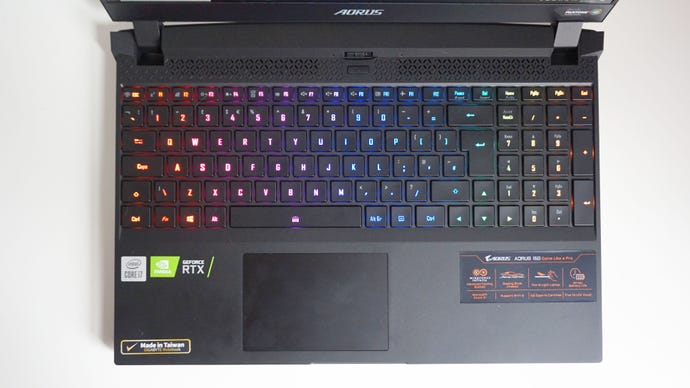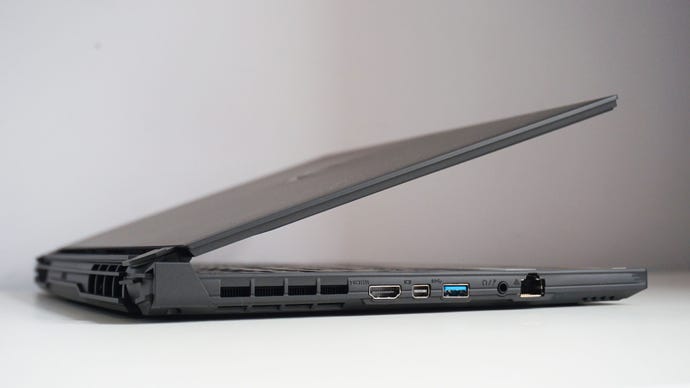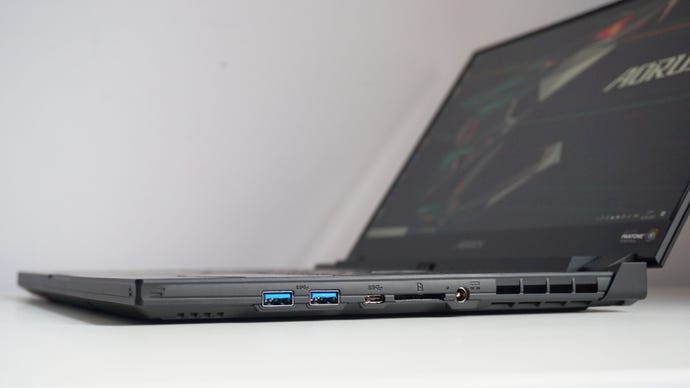Gigabyte Aorus 15G review
An RTX 3080 laptop with one major stumbling block
If the Asus ROG Strix Scar 15 represents the very best of what gaming laptops have to offer in 2021, then the Gigabyte Aorus 15G is probably what you'd call the next step down. It still has one of Nvidia's powerful new RTX 3080 graphics chips inside its slim black chassis, but it's the 8GB variant rather than the top 16GB one you get on the Scar. It also only has a 1920x1080 resolution display, albeit one with a higher 240Hz refresh rate, and its CPU is a fraction older as well, with Gigabyte choosing to stick with Intel's still very fast Core i7-10870H instead of opting for one of AMD's shiny new Ryzen 5000 chips. That's still a formidable set of specs, of course, and it's a potent combination for those after a top-notch 1080p gaming experience that will last for many years to come.
It also means the Gigabyte Aorus 15G is quite a bit cheaper than the Scar 15, and while £2300 / $2000 is still a sizable chunk of change for a gaming laptop, it is at least a tad bit friendlier than the Scar's current asking price of £2700 / $2700. Indeed, it's unlikely you'll find an RTX 3080 laptop for much less at the moment, as $2000 was the initial starting price set by Nvidia when these laptops were first announced back in January. The Gigabyte Aorus 15G is very much an entry-level RTX 3080 gaming laptop in that sense, but it's still got more than enough oomph for playing the latest games on max settings if you're not that fussed about having a higher resolution display.
Indeed, its Intel Core i7-10870H CPU and 32GB of RAM still offer plenty of processing grunt for everyday desktop tasks and light photo editing, and its Cinebench R20 scores of 370 for its single core performance and 3369 for its multicore performance were pretty much bang in line with what I was expecting. Yes, those results might be 21% and 31% slower respectively compared to the Scar 15's Ryzen 9 5900HX chip, but unless you regularly work with large video files or use a lot of intense creative applications in your day to day computing, then I'm not convinced you're really going to notice the difference.

Indeed, the impact they have on the laptop's 1080p gaming performance is pretty minimal. The Gigabyte Aorus 15G was often a couple of frames behind the Asus ROG Strix Scar 15 when it came to playing games at 1080p, but not enough to create a discernibly different gaming experience. Without the aid of a frame rate counter, both laptops felt pretty much identical at 1080p, offering near 60fps speeds on max settings in today's most demanding blockbuster games and well into the 80s, 90s and 100fps regions on games from the last couple of years.
In Shadow Of The Tomb Raider, for example, the Aorus 15G managed an admirable 87fps average on Highest settings with its tough SMAA x4 anti-aliasing setting switched on in the game's internal benchmark, which is just a single frame behind the Scar 15. The Scar 15 proved slightly more capable at running the game with its ultra ray tracing settings switched on, admittedly, finishing with an average of 66fps, but the Aorus 15G's score of 58fps with the same settings was still perfectly playable and felt just as smooth moment-to-moment.
Likewise, the way both laptops handled Total War: Three Kingdoms' benchmark felt nigh-on identical to me, with the Aorus 15G finishing with an average of 79fps on Ultra settings versus the Scar 15's 82fps. Both laptops proved equally capable of running Monster Hunter: World, too, with the Aorus 15G's average of 87fps on Highest feeling just as smooth as the Scar 15's average of 89fps.

It was a similar picture in Cyberpunk 2077 as well. The Aorus 15G's averaged a smooth 63fps on Ultra settings running around the crowded streets outside V's apartment building, which to my eyes felt pretty much the same as the Scar 15's average of 67fps. It was only when I swapped over to the game's RT Medium preset that the Scar 15's beefier innards started to make themselves known, as while the Asus was able to maintain a smooth average of 60fps with ray tracing switched on, the Aorus 15G only managed an average of 53fps. Still, we're not talking a huge difference overall.
Indeed, the Aorus 15G actually edged a couple of frames ahead of the Scar 15 in Forza Horizon 4, finishing its benchmark with an average of 134fps compared to the Scar 15's 132fps. To all intents and purposes, though, you're still looking at pretty much identical performance.
That said, there were still a couple of games where the Scar 15 established a firmer lead over the Aorus 15G, with the frame rate gap widening to around 8-10fps. Again, though, my eyes weren't nearly adept enough to be able to tell the difference between the two a lot of the time, but others may feel differently. In Assassin's Creed Valhalla, for example, the Aorus 15G ran at a very respectable average of 63fps on Ultra High settings in the game's internal benchmark, and while the Scar 15 is arguably a touch smoother at 72fps, it wasn't enough to make me feel like I needed to pay another £400 / $700 to make up for the shortfall.

It was a similar picture in Final Fantasy XV as well. Here, the Aorus 15G managed a wonderfully smooth average of 84fps on Highest running up and down the hills of Duscae, which to my eyes was much the same as the Scar 15's average of 93fps. Likewise for Metro Exodus. On Ultra settings, the Aorus 15G came in with an excellent result of 71fps in the game's demanding benchmarking tool, which in practice really didn't look that different to the Scar 15's average of 80fps. The Scar was once again a bit better at ray tracing than the Aorus 15G, but the Aorus still managed a very playable average of 54fps with ultra ray tracing thrown in, while the Scar 15 came in with an average of 64fps.
Again, though, I doubt most people will think that's worth paying another £400 / $700 for, especially when such problems are easily rectified by dropping down the overall quality settings a notch. Plus, when you compare the Aorus 15G's gaming performance to my previous favourite gaming laptop, the almost identically priced RTX 2080 Super-powered Lenovo Legion 7i, we're still looking at significantly better speeds across the board for the same amount of money, with the Aorus 15G often offering at least another 10fps on top of the Legion 7i, if not closer to 20fps.
Of course, maybe it's hypocritical to say the Aorus 15G is "significantly" better than the Legion 7i when I've just been saying that 10-odd fps makes little to no difference to your overall gaming experience. But you're getting more than just extra performance with the Aorus 15G, as this laptop also comes with a much higher 240Hz refresh rate display compared to that older Legion 7i model, which topped out at 144Hz (although I should note that Lenovo will be refreshing their Legion 7 laptops to include higher refresh rate RTX 30 models as well very soon). Sure, the games I've just tested might not be able to fill that kind of frame rate, but it does give you significantly more headroom if you're into competitive online shooters, and 2D indie games look absolutely sublime at 240fps as well.

The quality of the Aorus 15G's 15.6in, 1920x1080 IPS-grade display is pretty much just as good as the Legion 7i as well. My X-Rite DisplayPro i1 calibrator showed it was displaying an impressive 95.2% of the sRGB colour gamut out of the box, for example, which is only a fraction down from the Legion 7i's score of 99.4%. I also recorded an excellent contrast ratio of 1138:1 for the Aorus 15G, and combined with its low black level of 0.27cd/m2 (the closer to 0.00cd/m2, the better), there was plenty of dark shadow detail on show in games and photos alike. Its peak white level of 315cd/m2 also provided more than enough brightness for everyday use, and should be able to accommodate for a variety of different lighting conditions.
The Aorus 15G's 1TB NVMe SSD is nice and nippy as well, and its random read speeds are up there with the best laptop SSDs I've tested in recent months, coming in at 48MB/s in AS SSD's 1GB 4K random speed test. Its random write speeds aren't quite as fast as the competition sadly, but at 94MB/s, it's still perfectly adequate for everyday use.
The Aorus 15G also comes with a good supply of sensibly placed ports and display outputs, including an HDMI 2.1 output and a mini DisplayPort 1.4 output for connecting it up to an external display. This gives it a bit more flexibility than the Scar 15, which only came with a single HDMI 2.0b output.
Really, the only major hurdle I encountered with the Aorus 15G was its keyboard. Perhaps it's because I've just come from the wonderful opto-mechanical keyboard of the Scar 15, but typing up long word documents on the Aorus 15G was definitely a much less pleasurable experience overall. Its very flat island-style keys, their limited amount of travel and their compact spacing (this is one of the few 15.6in laptops I've tested recently to come with a built-in number pad) meant I was constantly making mistakes and putting my fingers in the wrong place when I first started using it. This did improve over time, though, and after a couple of days of intensive use I eventually got back up to my usual typing speed. I also didn't have a problem playing games on it, but if you're going to be using this for both work and play, then there are definitely better, less frustrating keyboards out there.

The touchpad, meanwhile, was perfectly fine for everyday use, although it probably goes without saying that you'll want to plug in a mouse for playing games. The touchpad is usable at a pinch for moving the camera around and doing some very limited click work at the same time, but you'll definitely be much better off bringing a mouse with you if you're gaming on the go.
Overall, while the Gigabyte Aorus 15G's keyboard is probably too much of a stumbling block for me to give it a full recommendation, it's proof that you don't necessarily need the full 16GB version of Nvidia's RTX 3080 chip to get the best performance. The Aorus 15G still has plenty of horsepower to deliver an exceptional gaming experience at 1080p, and its top notch display makes everything look pretty darn lovely in the process. Its SSD also has plenty of storage, and its sleek and subtle chassis isn't going to raise many eyebrows if you get it out in public (apart from its RGB back-lit keys, perhaps, which you can always turn off if you prefer).
As I said earlier, if you're buying this primarily as a laptop for playing games, then the keyboard may be less of an issue for you, in which case the Aorus 15G is probably worth considering as a cheaper alternative to the Asus ROG Strix Scar 15. However, if, like me, you want a gaming laptop for work and play, then I'd suggest looking elsewhere, as this will likely frustrate more than it delights.

